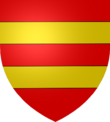House of Harcourt
| House of Harcourt | |
|---|---|
| Noble House | |

|
|
| Country |
|
| Titles |
in France : baron d'Harcourt baron d'Elbeuf (1265) comte d'Harcourt (1328) comte d'Aumale baron de Olonde marquis de Beuvron (1528) marquis de Thury comte de Sézanne comte de Lillebonne duc d'Harcourt (1700) and peer of France (1709) duc de Beuvron (1784) marquis d'Olonde-Harcourt marquis d'Harcourt (confirmed in 1814) and peer of France (1814), etc. in England : baron Harcourt of Stanton Harcourt (1711–1830) viscount Harcourt (1721–1830 and 1917–1979) earl Harcourt and viscount Nuneham (1749–1830) |
The House of Harcourt is a Norman family, descended from the Viking Bernard the Dane and named after its seigneurie of Harcourt in Normandy. Its mottos were "Gesta verbis praeveniant" (Olonde branch), "Gesta verbis praevenient" (Beuvron branch), and "Le bon temps viendra ... de France" (English branch).
In 1280 they established the Collège d'Harcourt in Paris, now the Lycée Saint-Louis at 44 boulevard Saint-Michel.
When in 911 the Viking chief Rollo obtained the territories that would make up Normandy through the Treaty of Saint-Clair-sur-Epte, he distributed domains to his main supporters among those who had accompanied him on his expeditions against the English and the Neustrians. After the conquest of Normandy, considerable lands (notably the seigneurie of Harcourt, near Brionne, were granted to Bernard the Dane as a reward for his exploits, and from him they descended upon the lords (seigneurs) of Harcourt.
The Harcourt family has been perpetuated up until the present day in a French branch and an English branch. The château d'Harcourt in Harcourt, Eure, Normandy, built around 1100, survives.
In the 11th century, Errand of Harcourt and his three brothers followed William the Conqueror, duke of Normandy, on the Norman invasion of England, and the brothers were installed with English lands. The English Harcourt branch entered the English peerage, as barons then viscounts then earls. At first the Harcourts had lands in Leicestershire, but in 1191 Robert de Harcourt of Bosworth inherited lands of his father-in-law at Stanton in Oxfordshire, which then became known as Stanton Harcourt. The manor of Stanton Harcourt has remained in the Harcourt family to the present day, although from 1756 to 1948 their main residence was at Nuneham House, also in Oxfordshire. Simon Harcourt was created Baron Harcourt in 1711 and Viscount Harcourt in 1721. The third viscount was created Earl Harcourt in 1749, but all titles were extinguished with the death of marshal William Harcourt, 3rd Earl Harcourt, in 1830. His cousin Edward Vernon, Archbishop of York, thus inherited the majority of that branch's lands and titles and took the name and heraldic shield of the English Harcourt family by royal authorisation on 15 January 1831. This created the Vernon-Harcourt branch, descended from a Harcourt woman. The title Viscount Harcourt was created a second time in 1917 for Lewis Harcourt, but the title was again extinguished on the death of his son.
...
Wikipedia
